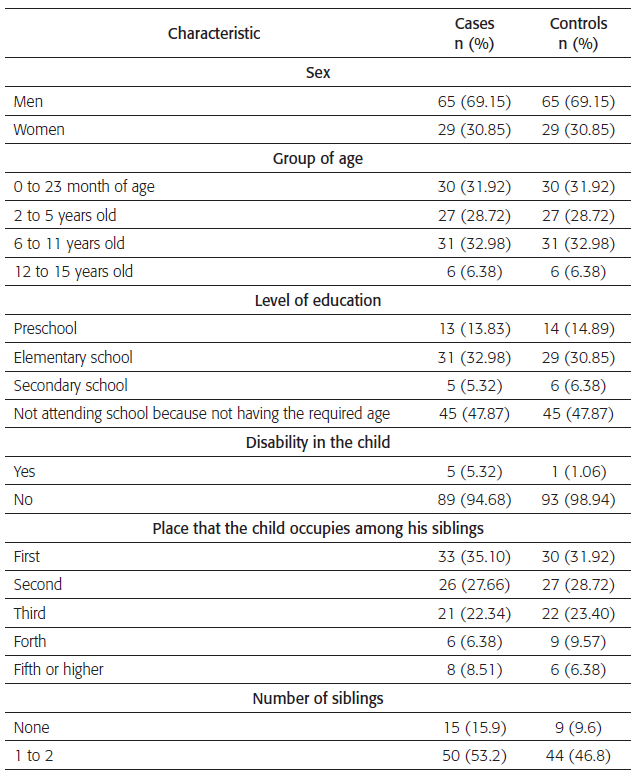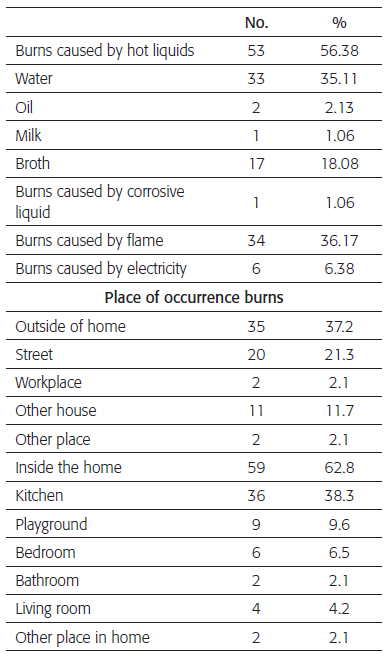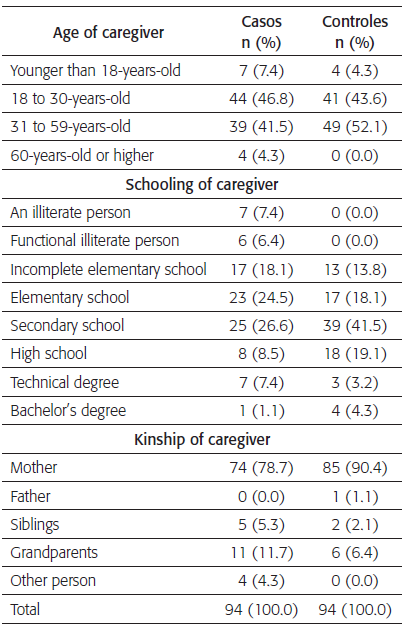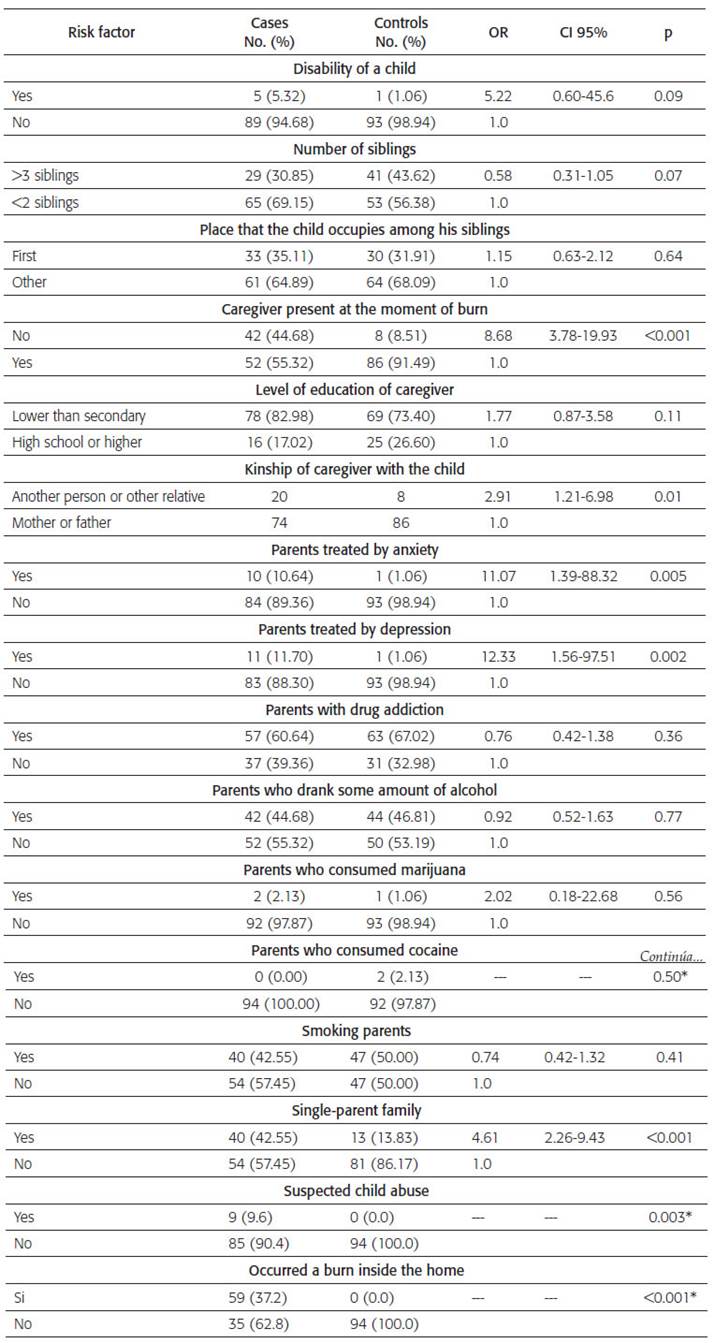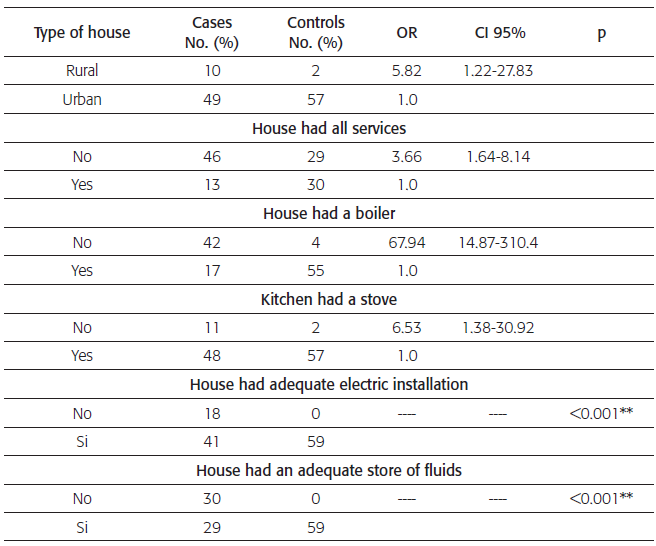BACKGROUND
Burns are the most traumatic injuries that a child can experience.1 In Mexico, these injuries represent a Public Health Problem owing to the fact that they are among the 20 leading causes of morbidity in populations aged 10-years-old or less.2 Approximately 36% of these events occur inside the home, with more than 50% of cases involving children under 15 years-of-age, out of which 79% are under 5-years-old.3 The most vulnerable children belong to low-income families.1,4-6Once these events occur, the process of medical treatment, recovery, and rehabilitation is long, and when the injury is severe, the process has physical, psychological, social, economic, and familial impacts on both the children and their families.7
In most cases, these events are entirely preventable. In several high-income countries, the prevention of burns in children has resulted in a 50% reduction in mortality.8 The strategies implemented explain that such results point to three major elements: person, environment, and social conditions; in this sense, a number of modification has been made in the legislation, design, and manufacture of a number of products, such as paraffin and some household chemicals. Likewise, other strategies have been implemented, such as home visits, support to families considered at risk, and the use of security devices.8 In Mexico, these strategies were established in 2016 by the initiative of the Technical Secretariat of the National Council for the Prevention of Accidents (STCONAPRA).
Together with other public institutions, a set of guidelines was constructed that contributes to the reduction of burns in vulnerable groups. The preventive actions were: installation of alarms against fire, the regulation of water temperature at home, the promotion of less flammable bedding and pyjamas, the use of a water sprinkler system on ceilings, among others.9 All those actions were used in contexts and populations with sufficient income, in contrast to other groups in Mexico that live in vulnerable conditions owing to a lack of economic income and medical insurance before the occurrence of their children's burns.8
In this situation, the analysis of elements in this population is necessary for the development of a design and to select prevention strategies for vulnerable families; specifically, low-income families without medical insurance. Therefore, the aim of this study is to estimate the risk of some elements of family dynamics and household structure in low-income families without medical insurance.
Patients and methods
This case-control study was conducted at the Civil Hospital of Guadalajara "Dr. Juan I. Menchaca" between May 2010 and January 2011. The ratio sample size was 1:1, paired by sex and age. The sample size was calculated with the following variable: depression in parents. We considered a frequency of 11.70% of parents with depression and whose children presented burns versus 1.06% in parents with children with other health conditions or other injuries. With that information, the minimum size sample was 166 people-83 per group, according to the OpenEpi application.10 The mental status of parents with children injured by burns was a less analyzed variable. Some studies referred that the parents could present symptoms of posttraumatic stress, anxiety, or depression in a lapse of time ranging from one to four weeks after injury; in addition, this situation could also affect the clinical evolution and treatment of children. Further, this situation can also increase with the existence of a foregoing mental disease, such as anxiety or depression.11-15
The inclusion criteria for each group were the following: the cases were children of both sexes who were hospitalized in the Medical Care Unit for Children with Burns. The controls were children of both sexes who had attended the Pediatric Emergency Service for another medical cause different to burns. The medical information was obtained from the Clinic Record and from the information provided by the relative responsible for the child present in the moment of injury with prior informed consent and oral acceptance of those responsible for the children, as established by the Regulation of the General Health Law on Subject-Matter of Health Research and in the consideration of this study as minimum-risk research.16 The investigation was evaluated by the Ethics Committee of Civil Hospital of Guadalajara "Dr. Juan I. Menchaca". The exclusion criteria were children hospitalized by burns and those diagnosed with child abuse or where they presented with an external cause of injury; with these criteria, no persons were excluded from the study. The suspicion of child abuse was defined as having at least one of the following characteristics: incomplete vaccination scheme, lack of birth registration, delay in medical care (> 24 hours), not attending school, and having any concomitant disease and no adherence to treatment.17,18 It is necessary to mention that none of the suspected cases detected in the study was confirmed after the corresponding legal study.
To collect the information, a collection form was drawn up that contained the following variables: a) sociodemographic data of child: sex, age, schooling, disability, birth place he/ she occupies among his/her siblings, number of siblings; b) agent of burn: agent that caused the burn, place of occurrence of the burn; c) sociodemographic data of caregiver: age, schooling, kinship of the caregiver with the child; d) elements of family dynamics present prior to the occurrence of the burn: present caregiver, schooling of caregiver, parents with anxiety treatment, parents with depression treatment, parents with substance abuse (including tobacco, alcohol, marijuana, or cocaine consumption), parents who consumed an amount of alcoholic beverages, parents with marijuana consumption, parents with cocaine consumption, smoking parents, single-parent family, number of people at home, suspected child abuse; e) elements of the home infrastructure: type of housing, the house has all utilities (i.e., gas, water service, electricity, telephone service, and sewer system), the house has a boiler, the kitchen has a stove, adequate electrical installation (when the electrical installation of the home was made by the company in charge of the supply), adequate storage of liquids (it was evaluated that household chemicals found in the home, which can cause a burn, were stored in containers with an airtight seal and out of reach of children).
The term "single-parent family" was defined as having one of the following criteria: children of divorced or separated parents, children of a single mother, children living with their mother or father and their partner (other than the father or the mother of the children in the study).
The capture of information and statistical analysis was carried out in the SPSS 22.0 software. Statistical analysis consisted of three phases: 1) obtaining frequencies and proportions, in addition to calculating the difference of proportions in the variables of schooling and kinship of the caregiver with the child. 2) calculation of Odds Ratio (OR) and 95% confidence interval to determine the association between the variables related to some elements of family dynamics and some elements of the household structure with the occurrence of burn; likewise, the value of p was estimated and found statistically significant a p smaller than 0.05. 3) Finally, those variables with a p value smaller than 0.25 were selected to introduce them to the logistic regression model. Sex and age variables (matching variables) were included to obtain the adjusted Odds Ratio (ORa) and 95% confidence intervals. As a secondary analysis study those children with burns that occurred inside the home were selected, together with an analysis of the risk factors of burns, in addition to some elements of household infrastructure, for which the frequencies were obtained, percentages, OR, and X 2 to obtain p value. In case of not being able to calculate OR due to any of the cells scoring zero, a Fisher's Exact Test was calculated, taking p<0.05 as statistically significant. To evaluate the goodness of fit for the logistic regression model, a Hosmer and Lemeshow test was applied, taking the p value greater than 0.05.
Results
The study groups have similar socio-demographic characteristics, in which a predominance of men can be observed (69.15%). In addition, two-thirds of the population (60.64%) in the study had an age of less than 5-years-old, with their schooling determined according to their age. When the burn occurred, the place he/she occupied among siblings was the first in the third part (35.10%), and, on average, they had 2 siblings. (Table 1).
Istudy, the most frequent burn injury in the children was caused by hot liquids among them, the most important was hot water (35.10%). Mainly, the place where burns predominantly occurred was inside the home (62.8%) (Table 2).
The age of the caregiver was located mainly in the group of 18 to 30 years (46.8%) in the case group of cases, and in the control group, the age range is from 31 to 59 years (52.1%). Schooling differed in both cases: the schooling of the caregiver was primary or inferior in 56.4%, whereas in the controls it was 31.9%, thus presenting a statistically significant difference (p<0.001). Regarding kinship of thecaregiver with the child, the parents were responsible for childcare in 78.7% of the cases and 91.5% of the controls. This difference was statically significant (p = 0.01) (Table 3).
The risk factors regarding burns in some of the elements related to the family dynamics of children found were not having a caregiver (OR 8.68, CI 95% 3.78-19.93), parents treated for anxiety (OR 11.07, CI 95% 1.39-88.32), parents treated for depression (OR 12.33, CI 95 1.56-97.51), belonging to a single-parent family (OR 4.61, CI 95% 2.26-9.43) and that the caregiver was another person or another family member of the child, except his/her mother and/or father (OR 2.91, CI 95% 1.21-6.98) (Table 4).
With regard to children who did not have a caregiver present at the time of the burn, a total of 50 children shared this characteristic. Their profile was 6.4 years (SD 4.5), the ratio by sex was 4.5:1 with greater affectation in boys (82.0%), one child had a disability (2.0%), and 58.0% had 2 siblings or less.
Statistical significance was found in the adjusted analysis when children had parents treated for depression (OR 15.55, CI 95% 1.84-131.08), were part of a single-parent family (OR 4.29, CI 95% 1.84-9.98) and those that did not have a caregiver at the time of the event (OR 13.44, CI 95% 5.14-35.15) Risk of burn was found to increase regardless of age and sex of the A factor that decreased the risk of burn by 59% in this study population was having three or more siblings (Table 5).
Table 5 Risk factors adjusted* of burns in children of low income family and without insurance
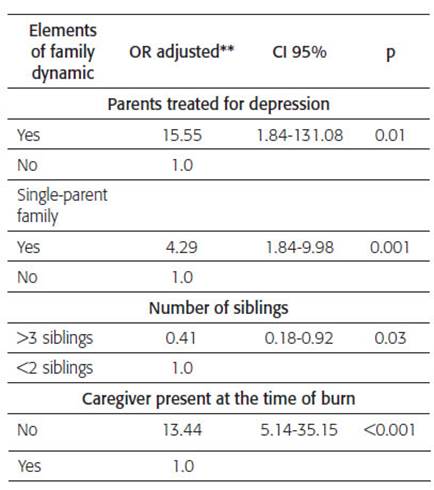
*Logistic Regression Model
**Information paired by age and sex
Source: Direct
Inside the home, some elements of household infrastructure were found to increase risk in the occurrence of burns, such as: living in a rural area, not having all services at home, not having a water heater or boiler, and not having a stove. It was also found that not having an adequate electrical installation and inadequate storage of fluids were associated with the presence of injury (p<0.001) (Table 6).
DISCUSSION
Risk factors of burns in children were: parents treated for depression (OR 15.55, CI 95% 1.84131.08), belonging to a single-parent family (OR 4.29, CI 95% 1.84-9.98), not having a caregiver present at the time of injury (OR 13.44, CI 5.14-35.15). Another factor that reduces the risk of burns is having three or more siblings. This factor was found to reduce 59% of the risk of burns.
Regarding the number of siblings, in other studies, it was observed that the existence of siblings was a risk factor of burn,19,20 especially in children under 5-years-old; however, this aspect was different in this study. This difference could be explained by changes in family structure, economy, family roles, and not having medical insurance; for example, a single-parent family where the mother needs to go out to work requires support from a person for the care of her children, a situation that could be lightened when medical insurance is available because an affiliated worker to medical insurance has access to kindergarten; likewise, having older siblings could reduce the risk of burns because sometimes they support care or have some skills to identify risks.
With regard to the occurrence of burns, in Lima, Peru, 5.7% of burn cases were reported when children stayed alone at home21; instead, 44.68% of the cases occurred in this study. In another aspect, the frequency was 20% higher for mothers that were caregivers of children, which is in contrast to the results shown by Delgado et al.21 In the other study, the frequency of other caregivers (meaning a person that was not the mother or the father of the child) was 17% lower than the frequency shown in this study (4.7% vs. 21.3%). The educational level of the caregiver was lower than high school (83% versus 81.6%), which does not indicate any important differences.22
In another study,23 it was reported that the frequency of scalding (17%) was found in the children of mothers with depression. In this study, the specificity of which of the parents were treated for depression was not documented; however, this frequency was lower than reported (11.70%). The parent's abuse of substances was associated with the occurrence of burns, and, in turn, this could produce less supervision and some type of child abuse as it had happened in another context,24,25 even when, in this study, this variable did not show a statistical association with occurrence of burns in the adjusted analysis.
The main agent that caused burns were hot fluids, as was the case in other cities, such as Lima, Peru21; Federal District, Mexico19,26; south-central China area27, and Cape Town, South Africa28. The other agent was hot soups (West Texas and Western New Mexico in the United States)29. This situation was similar to that shown in the study. Of the elements inside the home, it was found that living in a rural area, not having all services, and not having a boiler or stove in the house increased the risk of the occurrence of burns, and these are associated with low-income in families7, as was the case in Peru21, England, Wales, Scotland, and Northern Ireland23.
Another aspect that attracted attention was that the responsible person was between 12 to 17-years-old in 7.4% of the cases. It was found that this kind of person is limited by age owing to fluctuations in the conductive behavioral aspects of adolescence, which cause insecurity and rebellion, which could prevent them from taking care of others; in addition, this activity is not the responsibility of a teenager30. On the other hand, grandparents also participate as caregivers of their grandchildren. In this study, 4.3% of the cases were in the care of elderly. Caring for children was more frequent among grandparents, and it is estimated that of almost 3 million children who stay at home, 61% of them are in the care of their grandparents31. Although this issue was not the aim of this study, it is striking because it should be questioned as to whether senior citizens have any interest of taking care of their grandchildren, and if the latter person has the physical and mental capacity to do this activity32 because these conditions could increase the risk of burns or any other external injury inside the home.
The strengths of this study include the use of a case-control design paired with sex and age that allowed the researchers to establish a more consistent causal association in relation to other epidemiological studies. This study allowed the exploration of a vulnerable population; that is, a population without medical insurance and low-income, which, in our context, is the population with a higher risk of unintentional injuries as burns. The use of multivariate analysis allowed the creation of a model for a calculated statistical significance. The results of this study could be extrapolated for populations with similar characteristics, including Mexico, where approximately 40% of the population has no medical insurance, and affiliation to a health institution with medical insurance is associated to income; therefore, the lower the income a person has, the lower the possibility of having medical service will be33. Jalisco is not a state with a high vulnerability index34; however, other states of Mexico had a high index of vulnerability, and their risk of causing unintentional injury is higher.
The weaknesses of the study were: not including some other variables of family dynamics, such as parent occupation and the activities performed by the caregiver inside home while being in charge of children, as well as identifying the triggering cause for depression in parents, including the information reported in other studies, such as postpartum depression23 or unemployment.23
The risk factors found in this study could contribute initially to preventing burns in children inside the home, such as verifying where and how fluids are heated at home and the person in charge of caring for children, particularly because these injuries occur mainly in children under 5-years-old.
In the same way, it is necessary to plan and implement programs that reduce risk in the vulnerable population, as well as address mental health problems that may exist in parents.













